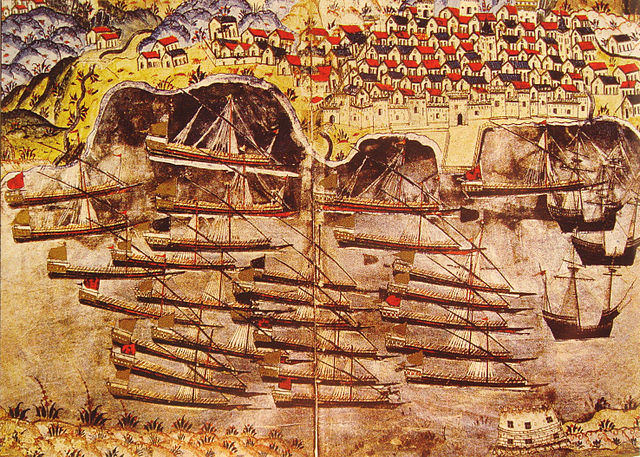Top Qs
Timeline
Chat
Perspective
Matrakçı Nasuh
Bosnian Ottoman polymath (1480 – c. 1564) From Wikipedia, the free encyclopedia
Remove ads
Nasuh bin Karagöz bin Abdullah el-Visokavi el-Bosnavî, commonly known as Matrakçı Nasuh (Turkish pronunciation: [matɾakˈtʃɯ naˈsuh]; Serbo-Croatian: Matrakčija Nasuh Visočak) for his competence in the combat sport of Matrak which was invented by himself, (also known as Nasuh el-Silâhî, Nasuh the Swordsman, because of his talent with weapons; 1480 – c. 1564) was a 16th-century Ottoman Bosnian[1][2] statesman of the Ottoman Empire, polymath, mathematician, philosopher, teacher, historian, geographer, cartographer, swordmaster, navigator, inventor, painter, farmer, and miniaturist.
He was brought to Istanbul after being recruited by Ottoman scouts in Rumelia. He was then educated, served several Ottoman sultans, and became a teacher at Enderun School.[3][4]
Remove ads
Life
Summarize
Perspective

Matrakçı Nasuh, born in the Bosnian town of Visoko,[5] was a Janissary who went through both the infantry and the devşirme system. He was a swordsman and sharpshooter who spoke five languages and was recruited into the Ottoman Navy.
Although born to Bosnian Muslim parentage, Nasuh was drafted into the devşirme system, usually reserved for the Christian populace of the empire. Exceptionally, however, in Bosnia, the devşirme was also extended to local Muslim families.[6][7][8]
After a long period of studying mathematics and geometry, he wrote his works Cemâlü'l-Küttâb and Kemalü'l- Hisâb and submitted them to the Ottoman sultan Selim I. He wrote also the two books named Mecmaü't-Tevârih and Süleymannâme, on history from 1520 to 1543. He also wrote a historical piece on the Persian campaign of Suleiman I titled Fetihname-i Karabuğdan. A recent study of his book Umdet-ul Hisab found that Matrakçı had invented some multiplication methods and that the lattice method had been widely used in the Enderun School nearly 50 years before John Napier reintroduced it to Europe.[1]

Besides his works on mathematics and history, he painted miniatures which focus on panoramic views of landscapes and cities painted with the greatest detail (his Istanbul landscape picture, shows almost every street and building of the city). In Ottoman miniature art, this was later known as the "Matrakçı style". One of his four volumes of miniatures deals with Suleiman I's Safavid war, upon which he had written his historical work Fetihname-i Karabuğdan. Besides illustrating the march of the Ottoman Army from Istanbul to Baghdad and then Tabriz and its return via Aleppo and Eskişehir, Nasuh also includes all the cities met by the army along the way. The Library of Istanbul University hosts the only copy of this work.
Nasuh was also a soldier and a master bladesmith. He worked as a weapons teacher at Enderun School. He and his students demonstrated their skills in a show which was part of the circumcision celebrations of Suleiman I's sons including future sultan Selim II. Because of his success in this demonstration, Nasuh received the honorary title of Ustad ("master") and Reis ("chief") from the sultan. He also wrote a book about usage of various weapons and techniques of cavalry and infantry fight, called Tuhfet-ül Guzât.[1][2][4][5][3]
Remove ads
Mathematics

Nasuh, who made a name for himself in mathematics, was especially interested in arithmetic and Algebra. He was the first to introduce the Lattice multiplication system.

Multiplication begins by multiplying two numbers in the same column from the far right of the row. Since the 4x5 product (20) is a two-digit number, the number in the theirs digit (2) is written above the mesh, and the number (0) in the ones digit is written below the mesh.
Remove ads
Works
Mathematics
- Cemâlü'l-Küttâb
- Kemalü'l- Hisâb
- Umdetü'l-Hisâb
History
- Mecmaü't-Tevârih (Sum of History)
- Süleymannâme (Book of Suleiman)
- Fetihname-i Karabuğdan (Book of Conquest of Moldavia)
- Beyan-ı Menazil-i Sefer-i Irakeyn-i Sultan Süleyman Han (Chronicle of Stages of Campaign of Iraq and Persia of Sultan Suleiman Khan)
- "TÂRÎH-İ ÂL-İ OSMÂN(Rüstem Pasha History)
- Tuhfet-ul Guzat (Gift of Warriors)
- "Târih-i Sultan Bâyezid
Gallery
- Map of Baghdad
- Miniaturised Map
- Miniaturised Map
- 16th century map of Soltaniyeh city by Matrakçı Nasuh
- 16th century map of Soltaniyeh city by Matrakçı Nasuh
- Map of Istanbul
- Map of Istanbul
- Map of Erzincan
Honors and legacy
In his hometown of Visoko, in Bosnia Matrakčija is regarded as a Bosnian Leonardo da Vinci.[9] A street near the Hometown Heritage Museum Visoko (Zavičajni Muzej Visoko) is named after him: Matrakčijina (English: Matrakci's Street).[10]
A documentary film about Matrakçı was produced by Turkish Radio-television in 1978.[9]
Fatih Al portrayed Matrakçı Nasuh Pasha in 2011's Magnificent Century.
References
External links
Wikiwand - on
Seamless Wikipedia browsing. On steroids.
Remove ads












